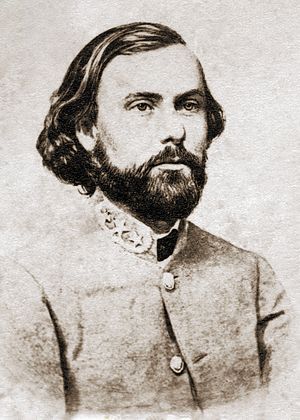Thomas C. Hindman
|
Major-General Thomas C. Hindman |
|
|---|---|

General Hindman during the Civil War
|
|
| Birth name | Thomas Carmichael Hindman, Jr. |
| Born |
January 28, 1828 Knoxville, Tennessee, United States |
| Died | September 27, 1868 (aged 40) Helena, Arkansas, United States |
| Buried at | Maple Hill Cemetery, Helena, Arkansas, United States |
| Allegiance |
|
| Service/branch |
|
| Years of service | 1846–1848 1861–1865 |
| Rank |
|
| Commands held |
|
| Battles/wars | |
| Other work | Politician |
Thomas Carmichael Hindman, Jr. (January 28, 1828 – September 27, 1868) was a lawyer, United States Representative from the 1st Congressional District of Arkansas, and major general in the Confederate States Army during the American Civil War.
Shortly after he was born in Knoxville, Tennessee, Hindman moved with his family to Jacksonville, Alabama, and later Ripley, Mississippi. After receiving his primary education in Ripley, he attended the Lawrenceville Classical Institute (now known as the Lawrenceville School) and graduated with honors. Afterwards, he raised a company in Tippah County for the 2nd Mississippi regiment in the Mexican–American War. Hindman served during the war as a lieutenant and later as a captain of his company. After the war, he returned to Ripley. He studied law, and was admitted to the state bar in 1851. He started a law practice in Ripley, and served as a member of the Mississippi House of Representatives from 1854 to 1856.
Hindman moved his law practice to Helena, Arkansas after his term in the Mississippi House ended. He was elected as the Democratic Representative from Arkansas's 1st congressional district in the Thirty-sixth Congress from March 4, 1859 to March 4, 1861. He was re-elected to the Thirty-seventh Congress, but declined to serve after the onset of the Civil War and Arkansas' secession from the Union. Instead, Hindman joined the armed forces of the Confederacy. He was promoted to brigadier general on September 28, 1861, and to major general on April 18, 1862. He commanded the Trans-Mississippi Department, and later raised and commanded "Hindman's Legion" for the Confederate States Army. After the war, Hindman avoided surrender to the federal government by fleeing to Mexico City. He worked in Mexico as a coffee planter and attempted to practice law. After the execution of Maximilian I of Mexico in 1867, Hindman submitted a petition for a pardon to President Andrew Johnson, but it was denied. Hindman, nonetheless, returned to his former life in Helena. He became the leader of the "Young Democracy", a new political organization that was willing to accept the Reconstruction for the restoration of the Union. He was assassinated on September 27, 1868 at his Helena home.
...
Wikipedia
